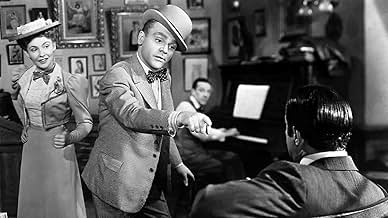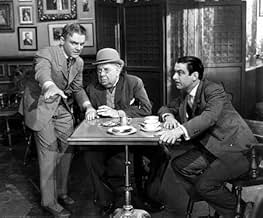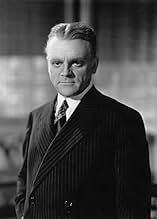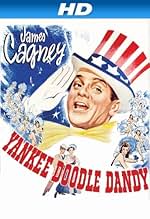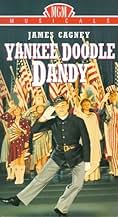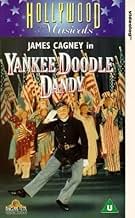AVALIAÇÃO DA IMDb
7,6/10
18 mil
SUA AVALIAÇÃO
A vida do renomado compositor musical, dramaturgo, ator, dançarino e cantor George M. Cohan.A vida do renomado compositor musical, dramaturgo, ator, dançarino e cantor George M. Cohan.A vida do renomado compositor musical, dramaturgo, ator, dançarino e cantor George M. Cohan.
- Direção
- Roteiristas
- Artistas
- Ganhou 3 Oscars
- 9 vitórias e 6 indicações no total
Patsy Parsons
- Josie Cohan - As a Girl of 12
- (as Patsy Lee Parsons)
Avaliações em destaque
James Cagney won his only Oscar for his recreation of George M. Cohgan in Yankee Doodle Dandy. Already terminally ill, Cohan lived long enough to see the film and no doubt he would have approved of it because it sure is how he would like to have been remembered.
In 1942 when Yankee Doodle Dandy premiered there was a whole generations of people left alive who saw George M. Cohan perform. Watching the film today Cohan is like a figure from antiquity. But Warner Brothers was lucky to have James Cagney with the studio who's dancing style closely paralleled Cohan's. If it is ever run on Turner Classic Movies, make sure you see George M. Cohan's sound film The Phantom President. You will be astonished to see how closely Cagney captured his style. In the same way that Philip Seymour Hoffman captured Truman Capote and Joaquin Phoenix became Johnny Cash.
Cohan's contemporaries are also like names from antiquity. But a century ago when Cohan was just hitting the big time performers like Fay Templeton, Nora Bayes, and Eddie Foy were very big stars and in 1942 plenty of people saw them also. I wish we had some film of them to see how Irene Manning, Frances Langford, and Eddie Foy, Jr. did in their recreations. I'm sure Foy, Jr. did a smashing job with his Dad.
The background stuff is true enough. Cohan was born to a pair of vaudeville performers Jerry and Nellie Cohan played here by Walter Huston and Rosemary DeCamp. Later on a sister was added to the Cohan family and here Josie Cohan is played by Jeanne Cagney. They did do all the towns, big and small, in America. Cagney meets wife Joan Leslie at Shea's Theater in Buffalo, New York and Shea's survives to this day. And his first real success was Little Johnny Jones which score included American classics, Yankee Doodle Dandy and Give My Regards to Broadway.
What's left out is the fact Cohan had two wives. His second wife survived him and died in the early Seventies. As his songs became popular in patriotic/rightwing circles, Cohan's personal politics reflected that. He fought hard and lost in the battle for Actors Equity. Cohan thought a union of players was tantamount to Communism. But such was his standing among performers that Cohan was granted the unique privilege of being allowed to appear on stage without having to join Equity once the union was recognized as the bargaining agent for players.
Cohan is shown in Yankee Doodle Dandy as gracefully having retired when other trends in popular music took over. Far from it, he was a very bitter man and when he did that final comeback in I'd Rather Be Right he fought with Kaufman and Hart over the book and Rodgers and Hart over the songs.
But Yankee Doodle Dandy presents the public musical face of George M. Cohan and does it very well. To this day, some forty years after first seeing Yankee Doodle Dandy on television, I love the recreations of Yankee Doodle Dandy, Give My Regards to Broadway, and You're a Grand Old Flag as they were first seen on stage. Plus some of the snatches of the lesser known Cohan songs as performed by the players portraying the Cohan family and others.
When all is said and done, George M. Cohan was a great force of nature in the American musical theater. And we thank his father, mother, and sister, and George M. himself for what he left us.
In 1942 when Yankee Doodle Dandy premiered there was a whole generations of people left alive who saw George M. Cohan perform. Watching the film today Cohan is like a figure from antiquity. But Warner Brothers was lucky to have James Cagney with the studio who's dancing style closely paralleled Cohan's. If it is ever run on Turner Classic Movies, make sure you see George M. Cohan's sound film The Phantom President. You will be astonished to see how closely Cagney captured his style. In the same way that Philip Seymour Hoffman captured Truman Capote and Joaquin Phoenix became Johnny Cash.
Cohan's contemporaries are also like names from antiquity. But a century ago when Cohan was just hitting the big time performers like Fay Templeton, Nora Bayes, and Eddie Foy were very big stars and in 1942 plenty of people saw them also. I wish we had some film of them to see how Irene Manning, Frances Langford, and Eddie Foy, Jr. did in their recreations. I'm sure Foy, Jr. did a smashing job with his Dad.
The background stuff is true enough. Cohan was born to a pair of vaudeville performers Jerry and Nellie Cohan played here by Walter Huston and Rosemary DeCamp. Later on a sister was added to the Cohan family and here Josie Cohan is played by Jeanne Cagney. They did do all the towns, big and small, in America. Cagney meets wife Joan Leslie at Shea's Theater in Buffalo, New York and Shea's survives to this day. And his first real success was Little Johnny Jones which score included American classics, Yankee Doodle Dandy and Give My Regards to Broadway.
What's left out is the fact Cohan had two wives. His second wife survived him and died in the early Seventies. As his songs became popular in patriotic/rightwing circles, Cohan's personal politics reflected that. He fought hard and lost in the battle for Actors Equity. Cohan thought a union of players was tantamount to Communism. But such was his standing among performers that Cohan was granted the unique privilege of being allowed to appear on stage without having to join Equity once the union was recognized as the bargaining agent for players.
Cohan is shown in Yankee Doodle Dandy as gracefully having retired when other trends in popular music took over. Far from it, he was a very bitter man and when he did that final comeback in I'd Rather Be Right he fought with Kaufman and Hart over the book and Rodgers and Hart over the songs.
But Yankee Doodle Dandy presents the public musical face of George M. Cohan and does it very well. To this day, some forty years after first seeing Yankee Doodle Dandy on television, I love the recreations of Yankee Doodle Dandy, Give My Regards to Broadway, and You're a Grand Old Flag as they were first seen on stage. Plus some of the snatches of the lesser known Cohan songs as performed by the players portraying the Cohan family and others.
When all is said and done, George M. Cohan was a great force of nature in the American musical theater. And we thank his father, mother, and sister, and George M. himself for what he left us.
`Yankee Doodle Dandy' makes the viewer say, `They don't make them like that anymore.' The film is uplifting for its espousal of unabashed patriotism and its representation of America as a place in which a gifted performer like George M. Cohan could rise from vaudeville to Broadway. It is also moving for its reverence for the nineteenth late century theatre and early twentieth century Broadway: the sequence showing Cohan's successes of the 1920s commemorate the other musical and non musical hits of the decade as much as Cohan's. I was moved to tears by the ending showing the elderly Cohan joining in a World War II parade, a group of soldiers marching to `Over There' and being asked why he isn't singing, `Hey old-timer, don't you know this song?' `Yankee Doodle Dandy' is a celebration of Cohan's life and career -- a little sanitised perhaps, but still portraying his love for his family, his profession and his country. It isn't a museum piece but more of a picture from another era and in a time when America is honoured by songs such as `Kick Ass USA' it's a valuable reminder of an age when people feeling their country under threat roused their nationalism by reminding themselves of what made them want to fight for it.
Right from the start, I have to say you do not need to be an American to be caught up in the excitement of the blatant flag waving tribute to a great artist. "Yankee Doodle Dandy" made to boost morale after the U.S. entered the war surely would have achieved its goal. It would have been even better in Technicolor (not the coloured version later shown). The songs were great, the acting and the individual dancing style of James Cagney was superb and deserved the Oscar. The two scenes featuring "Over There" were very moving with Frances Langford a standout! The story, while bearing small resemblance to real life, was good and Walter Huston and Rosemary de Camp were excellent. When you see a film such as this some 60 years after its release, and still really enjoy it, it shows how the Golden Years of Hollywood were just that.
The amazing piece of timing here is when Warner Bros. began work on this biography of entertainer George M. Cohan, WWII had not yet broken out. The attack on Pearl Harbor occurred the day before shooting began. When the film opened people on the home front badly needed some morale boosting, and this film gave it to them. It's just a joyous musical costume piece from start to finish with nice comic touches balanced with some sentimental moments (supposedly Walter Huston's deathbed scene had even taskmaster director Michael Curtiz crying). There's nothing in the way of real conflict or even much heavy in the way of romance between Cohan and his fictitious film wife "Mary", who was modeled after Cohan's actual second wife in some ways. Cohan was actually married twice. Oddly enough, it was Cohan who said he wanted as little romance in the film as possible.
The more I learn about Cohan the more I realize that Cagney was perfect to play him - both Irish Americans, both about the same size and build, and George Cohan's style of dancing and singing were about the same as Cagney's. It's hard to believe that Fred Astaire was Cohan's first choice to play himself. Astaire was a great talent, but I don't think he could have conveyed the combination of mischief, optimism and energy that was Cohan the way that Cagney ultimately did. Several people criticize Cagney's dancing here, but that eccentric style was Cohan's, who always considered himself more of an overall entertainer than a dancer in the first place.
If you're "date conscious" as I am, there are some matters of plot that might bother you. Cohan was born on July 2 or 3, not July 4. Cohan's mother outlived his father by eleven years and Cohan's father was not "very old" when he died as is said in the film - at least by today's standards. When Cohan's father died in 1917, he was only 69. Cohan's sister did die young - she was only 39, dying in 1916, plus she was not his little sister. Instead Josie was a year older than George. The film has Josie marrying when she would have been close to forty, when she actually married at the beginning of the 20th century and thus was the one to break up the four Cohans, not George. Also, Cohan received his Congressional Medal in 1936, not as WWII began as shown in the film. However the plot device of having George M. recount his life story to FDR, receiving his Congressional medal in the Oval Office, and then dance joyously down the White House stairs and into the streets joining a group of marching soldiers in a chorus of "Over There" was probably a great way to bridge Cohan's patriotic past with what was then an uncertain time that certainly needed a dose of his optimism.
The one thing that I did find a little odd - and one thing isn't much in a two plus hour long movie - is that it is hard to spot the actual point in the film where Mary becomes George's wife. There is quite a bit of domesticity shown before the two were married. Mary is cooking for George, staying in his apartment alone waiting for him to come home from the show, and acting very much like they are already married. The only way you know they are not is that George very subtly pops the question to the point that I'm surprised even Mary knew what he was asking! I know this doesn't seem like much in today's world, but considering that they were trying to paint Cohan in the most positive light possible and that the living arrangements might be misunderstood, I am surprised that the censors of that time never raised the issue.
At any rate, I highly recommend this one. You'll have a great time, at least in part because you can see that Cagney is having a great time. He always said this film was his favorite, and it shows in his performance.
The more I learn about Cohan the more I realize that Cagney was perfect to play him - both Irish Americans, both about the same size and build, and George Cohan's style of dancing and singing were about the same as Cagney's. It's hard to believe that Fred Astaire was Cohan's first choice to play himself. Astaire was a great talent, but I don't think he could have conveyed the combination of mischief, optimism and energy that was Cohan the way that Cagney ultimately did. Several people criticize Cagney's dancing here, but that eccentric style was Cohan's, who always considered himself more of an overall entertainer than a dancer in the first place.
If you're "date conscious" as I am, there are some matters of plot that might bother you. Cohan was born on July 2 or 3, not July 4. Cohan's mother outlived his father by eleven years and Cohan's father was not "very old" when he died as is said in the film - at least by today's standards. When Cohan's father died in 1917, he was only 69. Cohan's sister did die young - she was only 39, dying in 1916, plus she was not his little sister. Instead Josie was a year older than George. The film has Josie marrying when she would have been close to forty, when she actually married at the beginning of the 20th century and thus was the one to break up the four Cohans, not George. Also, Cohan received his Congressional Medal in 1936, not as WWII began as shown in the film. However the plot device of having George M. recount his life story to FDR, receiving his Congressional medal in the Oval Office, and then dance joyously down the White House stairs and into the streets joining a group of marching soldiers in a chorus of "Over There" was probably a great way to bridge Cohan's patriotic past with what was then an uncertain time that certainly needed a dose of his optimism.
The one thing that I did find a little odd - and one thing isn't much in a two plus hour long movie - is that it is hard to spot the actual point in the film where Mary becomes George's wife. There is quite a bit of domesticity shown before the two were married. Mary is cooking for George, staying in his apartment alone waiting for him to come home from the show, and acting very much like they are already married. The only way you know they are not is that George very subtly pops the question to the point that I'm surprised even Mary knew what he was asking! I know this doesn't seem like much in today's world, but considering that they were trying to paint Cohan in the most positive light possible and that the living arrangements might be misunderstood, I am surprised that the censors of that time never raised the issue.
At any rate, I highly recommend this one. You'll have a great time, at least in part because you can see that Cagney is having a great time. He always said this film was his favorite, and it shows in his performance.
James Cagney put down his tommy gun and grapefruit long enough to register his lone Oscar-winning performance in one of Hollywood's most enduring biopics, playing song-and-dance man George M. Cohan with so much gusto it's hard to believe the filmmakers wanted Fred Astaire, or that Cagney ever did anything else but musicals. Cohan himself probably didn't make as good a Cohan as Cagney does here.
The film is best-known for its musical moments, not only because of Cagney's clever hoofing but for the way the numbers are staged. When Cohan debuts his new song "You're A Grand Old Flag," the picture goes from being a relatively straight stage shoot to a series of logistically-improbable montages (a group of Boy Scouts give way to Revolutionary War troops, which melt into a knot of freed slaves gathered around a statue of Lincoln) that sell the history of the United States in all its glory. Finally, as the song winds to its big finish, hundreds and hundreds of uniformed flag bearers spill out on a stage suddenly too big to hold any conventional theater.
The overall effect of this is overwhelming enough to make you want to run out and buy War Bonds 60 years after the conflict "Yankee Doodle Dandy" was inspired by has ended. Patriotism may go out of style from time to time, but events happy and otherwise have a way of bringing it back.
The smaller touches make "Yankee Doodle Dandy" as entertaining as it is inspiring. Little Georgie gets too big for his britches when he tells a Brooklyn audience he can lick any kid in town, and gets put to the test. Older George and a partner beguile a producer (played by S.Z. Sakall, Carl from "Casablanca") into taking on a play no one else wants by pretending it's a hot property. George meets his future wife Mary in old-man costume, and can't resist having a little fun with her. "I know I have talent," Mary blurts, "even if I am from Buffalo."
Cagney does talk rather fast, and he needs to if only to keep pace with a frenetic storyline. Situations change rather quickly in "Yankee Doodle Dandy," and sometimes, as with George's sudden success and the later dissolution of the Four Cohans, it happens a bit too fast to follow. Cagney hardly pauses for breath. He's no singer, either, talking his way through his numbers like Rex Harrison in "My Fair Lady," only not as well.
But few films deliver the goods like "Yankee Doodle Dandy." You get a strong feeling for vaudeville entertainment, how mass entertainment worked in the gaslight age. The musical numbers (all done within the context of public performance, or else rehearsal, i.e. naturalistically) have real charm. The dialogue is great, too, a trifle canned and buffed-up maybe, but very Runyon-ish in its Stage Door Johnny way.
The best scene, for Cagney's acting and for comedy, is when he shows Mary a new song he wrote for her. The way his eyes move from her face to the score, prompting her unnecessarily, reveals both affection and the showman's inner ham. He almost looks menacing, but of course it's because he's smitten by the singer and trying to tell her through his song. It also sets up a great bit of comedy later on when George has to give Mary's song away to stage star Fay Templeton, then go back and explain it to Mary.
"He's the whole country squeezed into one pair of pants," exclaims one producer trying to get Templeton to hitch her wagon to Cohan's star. With Cagney wearing the pants, the end result is a perfect fit.
The film is best-known for its musical moments, not only because of Cagney's clever hoofing but for the way the numbers are staged. When Cohan debuts his new song "You're A Grand Old Flag," the picture goes from being a relatively straight stage shoot to a series of logistically-improbable montages (a group of Boy Scouts give way to Revolutionary War troops, which melt into a knot of freed slaves gathered around a statue of Lincoln) that sell the history of the United States in all its glory. Finally, as the song winds to its big finish, hundreds and hundreds of uniformed flag bearers spill out on a stage suddenly too big to hold any conventional theater.
The overall effect of this is overwhelming enough to make you want to run out and buy War Bonds 60 years after the conflict "Yankee Doodle Dandy" was inspired by has ended. Patriotism may go out of style from time to time, but events happy and otherwise have a way of bringing it back.
The smaller touches make "Yankee Doodle Dandy" as entertaining as it is inspiring. Little Georgie gets too big for his britches when he tells a Brooklyn audience he can lick any kid in town, and gets put to the test. Older George and a partner beguile a producer (played by S.Z. Sakall, Carl from "Casablanca") into taking on a play no one else wants by pretending it's a hot property. George meets his future wife Mary in old-man costume, and can't resist having a little fun with her. "I know I have talent," Mary blurts, "even if I am from Buffalo."
Cagney does talk rather fast, and he needs to if only to keep pace with a frenetic storyline. Situations change rather quickly in "Yankee Doodle Dandy," and sometimes, as with George's sudden success and the later dissolution of the Four Cohans, it happens a bit too fast to follow. Cagney hardly pauses for breath. He's no singer, either, talking his way through his numbers like Rex Harrison in "My Fair Lady," only not as well.
But few films deliver the goods like "Yankee Doodle Dandy." You get a strong feeling for vaudeville entertainment, how mass entertainment worked in the gaslight age. The musical numbers (all done within the context of public performance, or else rehearsal, i.e. naturalistically) have real charm. The dialogue is great, too, a trifle canned and buffed-up maybe, but very Runyon-ish in its Stage Door Johnny way.
The best scene, for Cagney's acting and for comedy, is when he shows Mary a new song he wrote for her. The way his eyes move from her face to the score, prompting her unnecessarily, reveals both affection and the showman's inner ham. He almost looks menacing, but of course it's because he's smitten by the singer and trying to tell her through his song. It also sets up a great bit of comedy later on when George has to give Mary's song away to stage star Fay Templeton, then go back and explain it to Mary.
"He's the whole country squeezed into one pair of pants," exclaims one producer trying to get Templeton to hitch her wagon to Cohan's star. With Cagney wearing the pants, the end result is a perfect fit.
Você sabia?
- CuriosidadesMany facts were changed or ignored to add to the feel of the movie. For example, the real George M. Cohan was married twice, and although his second wife's middle name was Mary, she went by her first name, Agnes. In fact, the movie deviated from the truth to such a degree that Cohan's daughter Georgette commented, "That's the kind of life Daddy would have liked to have lived."
- Erros de gravaçãoThe "You're A Grand Old Flag" number, supposedly takes place in the 1906 production of "George Washington Jr.," and uses multiple period flags to represent times before 1906. The Civil War flag, as an example, is correct for the time in question. However, in the final sequence characters carry, and an soft screen projection is made of, multiple 48 star flags. The 48 star flag was not introduced until 1912. In 1906, it should have been a 45 star flag. (Oklahoma was admitted to the Union in 1907, New Mexico and Arizona in 1912).
- Citações
George M. Cohan: My mother thanks you, my father thanks you, my sister thanks you, and I thank you.
- Versões alternativasAlso available in a computer colorized version.
- ConexõesFeatured in The Voice That Thrilled the World (1943)
- Trilhas sonorasThe Yankee Doodle Boy
(1904) (uncredited)
from the Broadway Show "Little Johnny Jones"
Written by George M. Cohan
Played during the opening credits
Sung and Danced by James Cagney and Chorus
Principais escolhas
Faça login para avaliar e ver a lista de recomendações personalizadas
- How long is Yankee Doodle Dandy?Fornecido pela Alexa
Detalhes
- Data de lançamento
- País de origem
- Idioma
- Também conhecido como
- Canção da Vitória
- Locações de filme
- Empresa de produção
- Consulte mais créditos da empresa na IMDbPro
Bilheteria
- Faturamento bruto nos EUA e Canadá
- US$ 11.800.000
- Tempo de duração2 horas 6 minutos
- Cor
- Proporção
- 1.37 : 1
Contribua para esta página
Sugerir uma alteração ou adicionar conteúdo ausente



